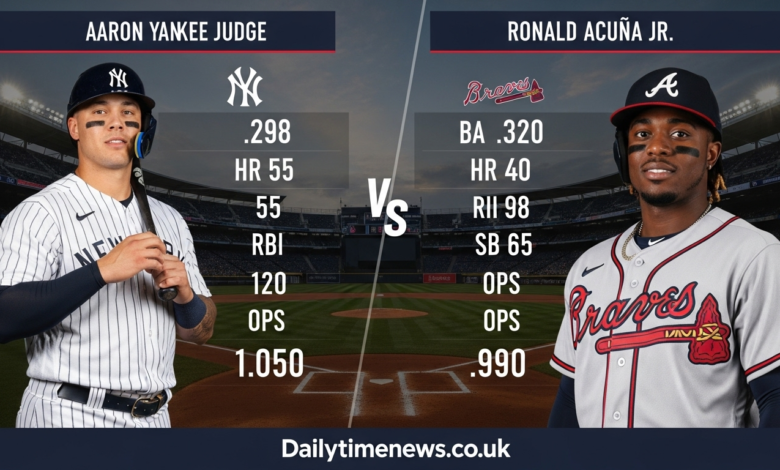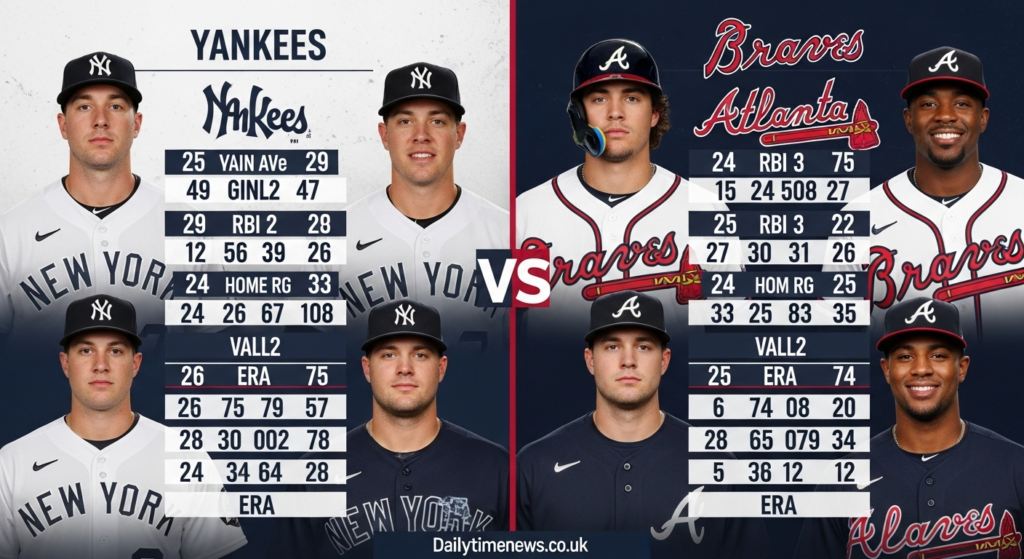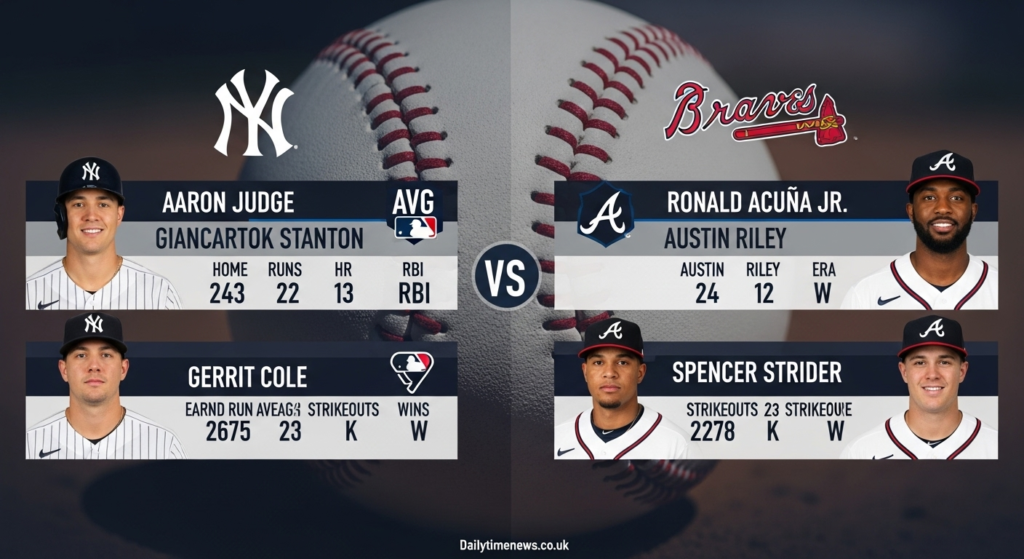Ultimate New York Yankees vs Atlanta Braves Match Player Stats

Introduction
Baseball fans know there’s something special when the New York Yankees and Atlanta Braves face off. These aren’t just regular season games. They’re showcases of talent, strategy, and pure competitive fire. When you’re looking at New York Yankees vs Atlanta Braves match player stats, you’re diving into a treasure trove of athletic excellence.
Both franchises represent baseball royalty. The Yankees with their 27 World Series championships and the Braves with their rich history spanning multiple cities. When these teams meet, individual performances often tell stories that statistics alone can’t capture. You see clutch hitting, dominant pitching, and defensive plays that shift momentum.
In this comprehensive guide, you’ll discover everything about the player statistics from Yankees vs Braves matchups. We’ll break down offensive numbers, pitching performances, defensive metrics, and historical context. Whether you’re a fantasy baseball player, a stats enthusiast, or just a fan wanting deeper insight, this article will give you the complete picture of how these baseball giants stack up against each other.
Historical Context of Yankees vs Braves Matchups
The Yankees and Braves rivalry carries significant weight in baseball history. These teams have met in the World Series multiple times, creating unforgettable moments. The 1996 and 1999 Fall Classics saw the Yankees triumph over the Braves, with individual performances etching themselves into baseball lore.
Interleague play brought more regular opportunities for these teams to face each other. Starting in 1997, fans could see Yankees vs Braves games during the regular season. This opened new chapters in their ongoing story and generated fresh statistical comparisons.
Geography plays a role in making these matchups interesting. New York’s intensity meets Atlanta’s Southern baseball tradition. The contrast in team cultures and fan bases adds flavor beyond the numbers. When you examine the stats, you’re also seeing different baseball philosophies clash.
The franchises have different approaches to building teams. The Yankees historically spend big on free agents. The Braves have often developed talent through their farm system. These different methodologies create fascinating statistical patterns when the teams compete directly.
Breaking Down Offensive Player Stats
When analyzing New York Yankees vs Atlanta Braves match player stats, offensive performance takes center stage. Let’s explore the key metrics that define how hitters from both teams perform in these matchups.
Batting Average and On Base Percentage
Batting average tells you how often a player gets a hit. In Yankees vs Braves games, contact consistency often determines outcomes. Historical data shows both teams feature players who elevate their game in these matchups.
Yankees hitters have traditionally posted strong batting averages against Braves pitching. Power hitters like Aaron Judge and Giancarlo Stanton can dominate any pitching staff. Their ability to make solid contact creates constant pressure on opposing defenses.
The Braves counter with their own offensive weapons. Players like Ronald Acuña Jr. and Matt Olson bring different skill sets. Acuña’s speed and contact ability contrast with Olson’s power approach. This diversity makes Braves’ offensive stats compelling across multiple categories.
On base percentage adds walks to the equation. Drawing walks demonstrates plate discipline and forces pitchers to throw strikes. Both teams emphasize getting on base through any means necessary. The team that controls the strike zone often controls the game.

Power Numbers: Home Runs and Slugging
Home runs change games instantly. When examining New York Yankees vs Atlanta Braves match player stats, power numbers often jump off the page. Both teams have built reputations as offensive juggernauts capable of explosive innings.
Yankees sluggers thrive in matchups against any opponent. The short porch in right field at Yankee Stadium favors left-handed power. When the Braves visit the Bronx, their pitchers must be extra careful. One mistake can turn into a game-changing blast.
Atlanta’s Truist Park also plays fair for power hitters. The dimensions allow for home runs while not being considered a true hitter’s park. Braves players take advantage, particularly when facing Yankees pitching that might not adjust well to National League parks.
Slugging percentage combines singles, doubles, triples, and homers into one metric. It shows total base productivity. High slugging percentages indicate a lineup that does damage beyond just getting on base. Both teams consistently rank among league leaders in this category.
RBI and Run Production
Runs batted in tell you who delivers in clutch situations. Players who drive in runs with runners in scoring position are invaluable. In tight Yankees vs Braves games, these moments often decide winners.
The Yankees’ lineup depth means multiple players contribute RBIs. You can’t pitch around one or two hitters when the entire order threatens. This depth creates statistical balance across the roster. Different players step up in different games, making prediction difficult.
Atlanta’s approach similarly spreads run production throughout the lineup. Their offensive philosophy emphasizes quality at-bats from every spot. Even the bottom of the order can hurt you. This consistency shows up in their cumulative statistics.
Total runs scored reflects overall offensive success. The team that scores more obviously wins. But examining individual contributions to run scoring reveals which players impact games most. Speed, power, and situational hitting all factor into these numbers.
Pitching Performance Analysis
Pitching often determines outcomes in Yankees vs Braves matchups. Let’s examine the key statistics that show how pitchers from both teams perform when facing each other.
Earned Run Average and WHIP
Earned run average measures how many earned runs a pitcher allows per nine innings. Lower ERAs indicate better performance. When you look at New York Yankees vs Atlanta Braves match player stats for pitchers, ERA tells much of the story.
Yankees starting pitchers face the challenge of quieting a potent Braves lineup. Gerrit Cole, when healthy, brings ace-level performance to these matchups. His ability to miss bats and limit hard contact shows up in his ERA and strikeout numbers.
The Braves rotation has featured strong arms like Spencer Strider and Max Fried. Strider’s high-octane fastball generates swings and misses. Fried’s crafty left-handed approach keeps hitters off balance. These contrasting styles create different statistical profiles against Yankees batters.
WHIP stands for walks and hits per inning pitched. It measures baserunners allowed. Keeping WHIP low means fewer scoring opportunities for opponents. Both teams emphasize pitchers who limit baserunners, as this directly correlates with preventing runs.
Strikeout Rates and Control
Strikeouts represent the ultimate pitcher dominance. When examining strikeout statistics in Yankees vs Braves games, you see which pitchers overpower opposing lineups. High strikeout rates indicate swing-and-miss stuff that batters struggle to handle.
Modern pitching emphasizes velocity and movement. Both teams feature pitchers who throw hard with late life on their pitches. This creates uncomfortable at-bats for hitters. The statistical result is elevated strikeout numbers across both rotations and bullpens.
Control matters equally. Walk rates show command and the ability to throw strikes. Pitchers who walk batters put themselves in trouble unnecessarily. Both the Yankees and Braves value pitchers with strong strike-throwing ability.
The strikeout-to-walk ratio combines these metrics. A high ratio indicates dominance and efficiency. Pitchers who strike out many while walking few give their teams the best chance to win. This statistic often predicts which pitcher will have success in any given matchup.
Quality Starts and Innings Pitched
Quality starts mean pitching at least six innings while allowing three or fewer earned runs. This benchmark shows whether a starter gave his team a chance to win. In Yankees vs Braves games, quality starts often directly correlate with victories.
The Yankees rotation aims for length and limiting damage. Getting deep into games protects the bullpen for later series games. Starters who consistently provide quality starts allow the team to manage pitching resources strategically.
Atlanta’s pitchers similarly focus on eating innings. The Braves have historically developed starters who work efficiently and stay healthy. This organizational philosophy produces pitchers with strong innings-per-start numbers.
Total innings pitched over a season or series shows durability. Pitchers who log significant innings carry enormous value. When key starters deliver in Yankees vs Braves matchups, their teams usually benefit in the standings.
Defensive Metrics That Matter
Defense doesn’t always show up in traditional box scores. However, defensive statistics reveal how players prevent runs through fielding excellence. Let’s examine defensive numbers from Yankees vs Braves matchups.
Fielding Percentage and Errors
Fielding percentage shows how often a player successfully completes a defensive play. While not perfect, it provides a baseline for defensive competence. Both teams pride themselves on solid fundamental defense that shows up in these numbers.
The Yankees infield features capable defenders at each position. Gold Glove caliber players have worn pinstripes throughout history. Current rosters continue this tradition with defenders who make routine plays consistently.
Atlanta’s defensive reputation has been built through shrewd player development. The organization emphasizes defense in player evaluation. This shows up in their fielding statistics, which typically rank among league leaders.
Errors cost games by giving opponents extra outs and opportunities. Teams that minimize errors put less pressure on their pitching. In close Yankees vs Braves games, a single error can shift momentum dramatically.
Range and Defensive Runs Saved
Advanced metrics like defensive runs saved quantify defensive impact more precisely. These statistics estimate how many runs a player prevents compared to an average defender. They account for range, arm strength, and positioning.
Outfield defense becomes crucial in these matchups given the power in both lineups. Outfielders who cover ground and prevent extra-base hits provide immense value. Aaron Judge’s combination of power hitting and quality outfield defense makes him invaluable.
The Braves have consistently fielded strong defensive outfields. Ronald Acuña Jr.’s speed allows him to track down balls other outfielders can’t reach. This range prevents doubles and triples that would otherwise score runs.
Infield defense affects outcomes through different mechanisms. Quick reactions, sure hands, and strong arms turn potential hits into outs. Both teams invest in defenders who excel in these areas, creating statistical advantages.
Key Player Matchup Statistics
Individual player matchups create fascinating statistical subplots. When specific Yankees batters face certain Braves pitchers, historical data reveals patterns worth noting.
Historical Batter vs Pitcher Stats
Some batters consistently hit certain pitchers well while struggling against others. These splits provide strategic information that managers use when setting lineups. In Yankees vs Braves games, these individual matchups can determine outcomes.
Yankees power hitters might have success against Braves pitchers who leave fastballs over the plate. Conversely, crafty Braves pitchers who locate breaking balls might neutralize those same sluggers. The chess match between opposing managers centers on these statistical edges.
The sample sizes in specific matchups can be small during regular season play. However, trends emerge over multiple meetings. A batter who’s 0 for 10 against a pitcher probably doesn’t match up well. Conversely, someone hitting .400 with two home runs has figured something out.
Platoon advantages factor heavily into these decisions. Left-handed batters typically hit right-handed pitchers better and vice versa. Both teams manipulate their lineups to maximize favorable matchups while minimizing unfavorable ones.
Clutch Performance in High Leverage Situations
Clutch statistics measure performance in crucial game moments. Late-inning at-bats with runners in scoring position define many games. Players who excel in these situations appear in New York Yankees vs Atlanta Braves match player stats as difference-makers.
The Yankees have historically featured clutch performers. Derek Jeter built his legend on postseason and late-game heroics. Current Yankees carry this expectation of delivering when games hang in the balance.
Braves players similarly embrace pressure moments. The franchise’s success over decades stems partly from players who thrive under pressure. These clutch performances show up in the statistics when examining close games between these teams.
Leverage index quantifies game situation importance. At-bats with two outs in the ninth inning of a one-run game have higher leverage than first-inning plate appearances. Players who maintain performance in high-leverage spots provide disproportionate value.
Speed and Baserunning Statistics
Baserunning doesn’t always receive the attention it deserves. However, aggressive baserunning creates runs and pressures defenses. Let’s examine speed-related statistics from Yankees vs Braves matchups.
Stolen Bases and Success Rate
Stolen bases add an exciting dimension to offensive strategy. When examining New York Yankees vs Atlanta Braves match player stats, stolen base numbers reveal which teams apply pressure on the basepaths.
The Braves historically featured speedy players who could steal bases. Ronald Acuña Jr. combines power with elite speed, making him a constant threat. When he reaches base, defenses must account for his ability to steal second or even third base.
Yankees teams have varied in their baserunning aggression. Recent rosters emphasize power over speed. However, they still feature players capable of stealing bases in crucial situations. The threat keeps defenses honest and creates strategic opportunities.
Stolen base success rate matters as much as total attempts. Getting caught stealing gives opponents free outs. Teams emphasize high-percentage situations where the risk-reward ratio favors attempting a steal.
Extra Base Running
Taking the extra base on hits demonstrates aggressive, intelligent baserunning. Turning singles into doubles or going first to third on base hits creates scoring opportunities. Both teams coach players to push for extra bases when situations allow.
Speed isn’t the only factor in successful baserunning. Reading outfielders, understanding game situations, and making quick decisions all contribute. Players who excel at baserunning create value beyond what traditional statistics capture.
The Yankees and Braves both emphasize proper baserunning fundamentals. Coaches work with players on reading balls off the bat, rounding bases efficiently, and knowing when to be aggressive. These skills show up in win probability added through baserunning.
Bullpen Performance in Close Games
Modern baseball increasingly relies on bullpens to protect leads. When examining Yankees vs Braves matchups, relief pitcher statistics often determine outcomes in close games.
Save Opportunities and Conversion Rates
Closers face immense pressure to convert save opportunities. One blown save can cost a team a crucial victory. Both franchises invest significant resources in finding reliable closers who handle these high-pressure situations.
The Yankees have featured dominant closers throughout their history. Mariano Rivera set the standard for excellence in the closer role. Current Yankees closers carry the weight of this legacy while facing elite competition.
Atlanta’s bullpen has gone through various phases. Recent seasons have seen improvement in late-inning reliability. The Braves understand that postseason success requires a shutdown bullpen capable of protecting narrow leads.
Save conversion percentage reveals consistency. A closer who converts 90% or more of save opportunities provides invaluable security. Managers can confidently hand them the ball knowing the game will likely end successfully.
Setup Men and Middle Relief
Setup men bridge the gap between starters and closers. These high-leverage relief pitchers face crucial innings, often with inherited runners. Their statistics show their ability to strand baserunners and keep games close.
Both teams employ multiple capable setup men who can pitch in various situations. Flexibility in bullpen usage has become essential in modern baseball. Having several pitchers who can handle the seventh and eighth innings creates strategic advantages.
Middle relievers eat innings when starters exit early. Their ability to prevent damage controls game situations. In long series between the Yankees and Braves, middle relief depth often determines which team maintains pitching strength throughout.
Recent Season Head to Head Statistics
Looking at recent seasons provides current context for Yankees vs Braves matchups. Let’s examine how recent meetings have unfolded statistically.
2023 Season Matchup Overview
The 2023 season saw the Yankees and Braves meet in interleague play. Both teams entered their matchups with playoff aspirations. The games provided crucial opportunities to gain ground in their respective divisions and wild card races.
Individual performances in these games often reflected season-long trends. Players having strong seasons continued their success while those struggling sought to break out against quality competition. The statistics from these matchups mirrored overall season performance for most players.
Specific players elevated their games in these high-profile matchups. The spotlight of Yankees vs Braves games brings out competitive fire. You often see players posting numbers above their season averages when facing premier opponents.
Notable Individual Performances
Certain games feature dominant individual performances that stand out statistically. A pitcher throwing eight shutout innings or a hitter going 4 for 5 with two home runs creates memorable statistical lines that fans remember.
Aaron Judge’s performances against the Braves showcase his ability to dominate any opponent. His combination of power, patience, and contact ability makes him a constant threat. When he gets hot, the statistical damage can be overwhelming.
Ronald Acuña Jr. similarly terrorizes Yankees pitching when he’s locked in. His unique five-tool skillset means he can hurt opponents in multiple ways. Whether stealing bases, hitting home runs, or making defensive plays, his impact shows up across statistical categories.
Comparing Team Statistics in Matchups
Beyond individual player stats, team-level statistics reveal broader patterns. Comparing how the Yankees and Braves perform collectively provides strategic insights.
Run Differential in Series
Run differential shows the margin by which teams outscore opponents. In Yankees vs Braves series, this number often predicts which team claims the series victory. The team scoring more runs across multiple games typically wins more individual contests.
Offensive explosions and pitcher’s duels create different statistical profiles. A series might feature high-scoring slugfests where both teams post double-digit run totals. Alternatively, tight, low-scoring games showcase pitching and defense.
The context of when runs are scored matters enormously. Scoring ten runs in a blowout loss provides less value than manufacturing three runs in a close win. Quality teams find ways to score when it matters most.
Situational Hitting Statistics
Batting with runners in scoring position represents a crucial situational stat. Teams that hit well in these situations win more games. The Yankees and Braves both emphasize clutch hitting throughout their lineups.
Two-out hitting creates another important subset of statistics. Getting hits with two outs extends innings and creates scoring opportunities. Both teams feature players who don’t give away outs even when facing two strikes.
Batting with runners on base generally produces different results than batting with bases empty. Some hitters thrive under the added pressure while others struggle. Examining these splits reveals which players deliver when the game situation demands it.
The Impact of Home Field Advantage
Home field advantage shows up in statistics across all sports. In baseball, familiar surroundings, supportive crowds, and ballpark dimensions all contribute. Let’s examine how location affects Yankees vs Braves matchup statistics.
Yankee Stadium vs Truist Park
Yankee Stadium’s short right field porch famously favors left-handed power hitters. The 314-foot distance down the line allows fly balls that would be routine outs elsewhere to become home runs. This dimension affects how both teams approach games in the Bronx.
Braves left-handed hitters particularly benefit when visiting New York. They can take advantage of that inviting target in right field. Conversely, Yankees left-handed sluggers feast on their home ballpark dimensions throughout the season.
Truist Park in Atlanta presents more balanced dimensions. The ballpark doesn’t extremely favor hitters or pitchers. This neutrality means player talent determines outcomes more than ballpark factors. Both teams face a fair playing field when the series moves to Georgia.
Statistical Home and Away Splits
Most teams perform better at home than on the road. Examining home and away splits for Yankees and Braves players reveals this pattern. Comfort with surroundings, avoiding travel fatigue, and fan support all contribute to better home performance.
Some players show dramatic home/road splits while others maintain consistency regardless of location. Identifying which players travel well helps predict performance in road series. These statistical trends provide betting insights and fantasy baseball information.
The long baseball season means teams spend roughly half their time on the road. Building a roster with players who perform well in all environments creates sustainability. Both franchises seek players whose statistics remain stable whether home or away.
Using Player Stats for Fantasy Baseball
Fantasy baseball players devour statistics when setting lineups. Yankees vs Braves matchups provide valuable data points for fantasy decisions. Let’s explore how to use these stats effectively.
Identifying Favorable Matchups
Checking pitcher vs batter history helps you identify favorable fantasy matchups. If your Yankees hitter has historically crushed a particular Braves pitcher, starting that player makes sense. Conversely, benching someone who struggles against a specific pitcher could save your weekly stats.
Ballpark factors influence fantasy decisions significantly. When the matchup takes place at Yankee Stadium, starting left-handed power hitters becomes more attractive. The short porch increases home run probability, boosting your fantasy point potential.
Recent form matters as much as historical stats. A player in a hot streak might overcome historically poor performance against a pitcher or team. Balancing historical data with current performance creates optimal fantasy lineups.
Projecting Statistical Production
Projection systems use historical data to estimate future performance. When Yankees face the Braves, these projections account for specific matchups, ballpark factors, and recent trends. Understanding how projections work helps you make informed fantasy decisions.
Counting statistics like home runs, RBIs, runs scored, and stolen bases drive fantasy value for hitters. Identifying which Yankees and Braves players will accumulate the most counting stats helps you maximize fantasy points.
For fantasy pitching, strikeouts, wins, ERA, and WHIP determine value. Streaming pitchers facing weaker lineups can provide value. However, both the Yankees and Braves field strong offenses that make them risky opponents for streaming candidates.
Historical Postseason Encounters
While this article focuses on regular season stats, the historical postseason meetings between these franchises add context. The Yankees and Braves have World Series history that elevates their regular season matchups.
World Series Meetings
The 1996 World Series saw the Yankees defeat the Braves in six games. This championship ended New York’s long title drought. Individual performances in that series, like Jim Leyritz’s home run, became legendary.
The 1999 World Series featured a Yankees sweep of the Braves. New York’s dynasty dominated a talented Atlanta squad. The statistical domination in that series showcased the Yankees’ superiority during that era.
These historical matchups influence how fans and players approach current games. The institutional memory of past championships adds weight to regular season meetings. Players want to prove themselves against franchises with such decorated histories.
The Role of Analytics in Modern Matchups
Modern baseball relies heavily on analytics and advanced statistics. Understanding how both teams use data provides insight into their strategies during matchups.
Advanced Metrics Both Teams Emphasize
Launch angle and exit velocity have revolutionized hitting approaches. Both the Yankees and Braves use this data to optimize swings. Players work on elevating the ball with authority, leading to more home runs and extra-base hits.
Spin rate and pitch movement data help pitchers maximize effectiveness. Understanding which pitches generate the most swings and misses allows pitchers to attack hitters’ weaknesses. Both organizations invest heavily in pitching analytics.
Defensive positioning based on spray charts has become standard. The Yankees and Braves shift defenders according to data on where specific hitters hit the ball. This reduces hits and run scoring, showing up in improved defensive statistics.
How Analytics Influence In-Game Decisions
Managers increasingly rely on data when making pitching changes. Matchup statistics, rest days, and workload management all factor into bullpen decisions. The days of riding hot hands or trusting gut feelings have largely passed.
Lineup construction uses sophisticated algorithms that maximize run scoring probability. The order in which players bat affects run production. Both teams optimize their batting orders using analytical models.
Defensive shifts create controversy but undeniably affect statistics. Players see different defensive looks based on data about their hitting tendencies. This chess match between hitters and defenses influences the statistical outcomes of every plate appearance.

Conclusion
New York Yankees vs Atlanta Braves match player stats tell rich stories about baseball excellence. From offensive explosions to pitching dominance, these matchups showcase the sport at its highest level. Understanding the statistics deepens your appreciation for individual performances and team strategies.
The numbers reveal patterns, trends, and outliers that shape outcomes. Whether you’re analyzing batting averages, ERAs, or advanced metrics, each statistic provides a piece of the larger picture. Both franchises feature world-class talent that produces compelling statistical battles.
As you follow future Yankees vs Braves matchups, pay attention to these statistical categories. Notice which players elevate their games and which struggle. The stats provide objective measures of performance while the games themselves deliver the drama and excitement that make baseball beautiful.
What statistics do you find most valuable when analyzing these matchups? Do traditional stats like batting average and ERA tell you enough, or do you dive into advanced metrics? Share your thoughts on how you use player stats to enhance your baseball viewing experience!
Frequently Asked Questions
Where can I find live New York Yankees vs Atlanta Braves match player stats? You can find live player stats on MLB.com, ESPN, and team-specific websites. These platforms update statistics in real-time during games, showing batting averages, pitch counts, and other key metrics as the action unfolds.
Who typically performs better in Yankees vs Braves matchups historically? The Yankees hold the historical edge with World Series victories in 1996 and 1999. However, recent regular-season matchups have been competitive, with outcomes varying based on current roster strength and home field advantage.
What are the most important stats to watch in Yankees vs Braves games? Focus on batting average with runners in scoring position, quality starts from pitchers, bullpen ERA, and home run totals. These statistics often correlate most directly with winning outcomes in matchups between these offensive-minded teams.
How do ballpark dimensions affect player statistics in these matchups? Yankee Stadium’s short right field porch (314 feet) significantly increases home run totals for left-handed hitters. Truist Park offers more balanced dimensions, making it less of a factor in statistical outcomes.
Which players have the best career stats in Yankees vs Braves matchups? This varies by era, but current stars like Aaron Judge for the Yankees and Ronald Acuña Jr. for the Braves typically post strong numbers. Historical players from World Series meetings also left impressive statistical legacies.
How can I use these player stats for fantasy baseball decisions? Check recent performance trends, historical batter vs pitcher matchups, and ballpark factors. Players in hot streaks facing favorable matchups should be in your starting lineup, while those struggling against specific pitchers might be better benched.
Do the Yankees and Braves play each other in spring training? Occasionally, yes. Spring training schedules vary yearly, but when these teams meet in Florida during exhibition season, the games provide early looks at player performance, though statistics from these games don’t count toward regular season totals.
What role do advanced statistics play in these matchups? Both teams heavily utilize analytics for defensive positioning, pitching matchups, and lineup construction. Advanced metrics like exit velocity, launch angle, and spin rate inform strategic decisions that affect the statistical outcomes you see.
How many times do the Yankees and Braves typically play each season? Under the current MLB schedule format, interleague matchups occur regularly but the exact number varies by year. Typically, they meet for a three or four-game series during the regular season, either in New York or Atlanta.
Where can I find historical player statistics from past Yankees vs Braves games? Baseball-Reference.com provides comprehensive historical statistics. You can search specific date ranges, playoff series, or individual player performance against particular teams going back decades.
Also Read Dailytimenews.co.uk




